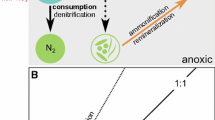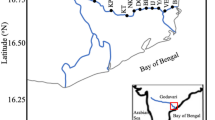Abstract
Lake Superior, one of the largest lakes in the world, is an ecosystem where nitrate (NO3 −) concentration has risen almost fivefold in the last century. Recent studies suggest that this increase may be due to lack of a significant nitrogen (N) sink, such as sedimentary denitrification or burial, because of low organic matter supply to the lake bottom. In light of these new findings, it is imperative to examine the origin and transformation of suspended particulate organic matter (POM) in the lake as N biogeochemistry is inextricably linked to POM dynamics. We present an analysis of spatial and temporal variations in δ15Ν of POM (δ15ΝPOM) in the lake and draining rivers based on extensive sampling and a synthesis of recent studies of N cycling. The δ15ΝPOM in the lake ranged from −4.7 to 7.6‰ and showed a significant (p < 0.001) temporal variability in the surface waters with relatively enriched δ15Ν during winter (mean ± SD ~ 1.5 ± 2.3‰; n = 13) compared to summer (mean ± SD ~ −2.0 ± 1.4‰; n = 20). Temporal variability in δ15ΝPOM and data for δ15Ν of dissolved inorganic nitrogen (DIN) together suggest a seasonal shift in nutrient sources for plankton along with possible detrital and higher trophic level contributions to POM during winter. On an annual basis, ammonium (NH4 +) appears to be the dominant N source to plankton in the lake. NO3 − use was lower but seasonally variable with higher contributions to plankton in summer than winter. During a period of high riverine discharge, no significant difference in coastal and open-lake δ15ΝPOM was found, indicating limited effect of riverine POM on the lake. Significant increase in δ15ΝPOM and decreases in particulate N concentration with depth indicate transformations of organic matter settling to the lake bottom that are consistent with the hypothesized influence of low organic matter supply to the lake bottom leading to limited benthic denitrification.









Similar content being viewed by others
References
Adams TS, Sterner RW (2000) The effect of dietary nitrogen content on trophic level 15N enrichment. Limnol Oceanogr 45(3):601–607
Alldredge AL, Gottschalk CC (1988) Direct observations of mass flocculation of diatom blooms: characteristics, settling velocities and formation of diatom aggregates. Deep Sea Res 36:159–171
Altabet MA (1988) Variations in nitrogen isotopic composition between sinking and suspended particles: implications for nitrogen cycling and particle transformation in the open ocean. Deep Sea Res A 35:535–554
Altabet MA (1996) Nitrogen and carbon isotopic tracers of the source and transformation of particles in the deep sea. In: Ittekkot V, Schafer P, Honjo S, Depetris PJ (eds) Particle flux in the ocean. John Wiley, New York, pp 155–184
Altabet MA, McCarthy JJ (1986) Vertical patterns in 15N natural abundance in PON from the surface waters of warm core rings. J Mar Res 44:185–201
Altabet MA, Deuser WG, Honjo S, Stienen C (1991) Seasonal and depth-related changes in the source of sinking the North Atlantic. Nature 354:136–139
Axler RP, Redfield GW, Goldman CR (1981) The importance of regenerated nitrogen to phytoplankton productivity in a subalpine lake. Ecology 62:345–354
Bacon MP, Huh CA, Fleer AP, Deuser WG (1985) Seasonality in the flux of natural radionuclides and plutonium in the deep Sargasso Sea. J Mar Res 44:185–201
Baker JE, Eisenreich SJ, Eadie BJ (1991) Sediment trap fluxes and benthic recycling of organic carbon, polycyclic aromatic hydrocarbons, and polychlorobiphenyl congeners in Lake Superior. Environ Sci Technol 25:500–509
Bennett EB (1986) The nitrifying of Lake Superior. Ambio 15:271–275
Berman T, Sherr BF, Sherr E, Wynne D, McCarthy JJ (1984) The characteristics of ammonium and nitrate uptake by phytoplankton in Lake Kinneret. Limnol Oceanogr 29:287–297
Carlton RG, Walker GS, Klug MJ, Wetzel RG (1989) Relative values of oxygen, nitrate, and sulfate to terminal microbial processes in the sediments of Lake Superior. J Great Lakes Res 15(1):133–140
Carpenter EJ, Harvey HR, Fry B, Capone DG (1997) Biogeochemical tracers of the marine cyanobacterium Trichodesmium. Deep Sea Res 44:27–38
Cloern JE, Canuel EA, Harris D (2002) Stable carbon and nitrogen isotope composition of aquatic and terrestrial plants of the San Francisco Bay estuarine system. Limnol Oceanogr 47(3):713–729
Cotner JB, Biddanda BA, Makino W, Stets E (2004) Organic carbon biogeochemistry of Lake Superior. Aquat Ecosys Health Manag 7(4):451–464
Eadie BJ, Chambers RL, Gardner WS, Bell GL (1984) Sediment trap studies in Lake Michigan: resuspension and chemical fluxes in the southern basin. J Great Lakes Res 10(3):307–321
Ferber LR, Levine SN, Lini A, Livingstone GP (2004) Do cyanobacteria dominate in eutrophic lakes because they fix atmospheric nitrogen? Fresh Water Biol 49:690–708
Finlay JC, Sterner RW, Kumar S (2007) Isotopic evidence for in-lake production of accumulating nitrate in Lake Superior. Ecol Appl 17(8):2323–2332
Fisher TR, Morrissey KM, Carlson PR, Alves LF, Melack JM (1988) Nitrate and ammonium uptake by plankton in an Amazon River floodplain lake. J Plank Res 10:7–29
Fogel ML, Cifuentes LA (1993) Isotope fractionation during primary production. In: Engel MH, Macko SA (eds) Organic geochemistry: principles and applications. Plenum Press, NY, pp 73–98
Gu B (2009) Variations and controls of nitrogen stable isotopes in particulate organic matter of lakes. Oecologia 160:421–431
Hadas O, Altabet MA, Agnihotri R (2009) Seasonally varying nitrogen isotope biogeochemistry of particulate organic matter in Lake Kinneret, Israel. Limnol Oceanogr 54(1):75–85
Halfon E (1984) The composition of particulate organic matter in the euphotic zone of Lake Superior. J Great Lakes Res 10:299–306
Harvey CJ, Kitchell JF (2000) A stable isotope evaluation of the structure and spatial heterogeneity of a Lake Superior food web. Can J Fish Aquat Sci 57:1395–1403
Hoch MP, Snyder RA, Cifuentes LA, Coffine RB (1996) Stable isotope dynamics of nitrogen recycled during interactions among marine bacteria and protists. Mar Ecol Prog Ser 132:229–239
Holmes RM, McClelland JW, Sigman DM, Fry B, Peterson BJ (1998) Measuring 15N–NH4 in marine, estuarine and fresh waters: an adaptation of the ammonia diffusion method for samples with low ammonium concentrations. Mar Chem 60:235–243
Holmes ME, Eichner C, Struck U, Wefer G (1999) Reconstruction of surface ocean nitrate utilization using stable nitrogen isotopes in sinking particles and sediments. In: Fischer G, Wefer G (eds) Use of proxies in paleoceanography: examples from the South Atlantic. Springer, Berlin, pp 447–468
Kendall C, Silva SR, Kelly VJ (2001) Carbon and nitrogen isotopic compositions of particulate organic matter in four large river systems across the United States. Hydrol Process 15:1301–1346
Keough JR, Sierszen ME, Hagley CA (1996) Analysis of Lake Superior costal food web with stable isotope techniques. Limnol Oceanogr 41(1):136–146
Kumar S, Ramesh R, Bhosle NB, Sardesai S, Sheshshayee MS (2004) Natural isotopic composition of nitrogen in suspended particulate matter in the Bay of Bengal. Biogeosciences 1:63–70
Kumar S, Sterner RW, Finlay JC, Brovold S (2007) Spatial and temporal variation of ammonium in Lake Superior. J Great Lakes Res 33:581–591
Kumar S, Sterner RW, Finlay JC (2008) Nitrogen and carbon uptake dynamics in Lake Superior. J Geophys Res 113: G04003. doi:10.1029/2008JG000720
Lehmann MF, Bernasconi SM, McKenzie JA (2004) Seasonal variation of the δ13C and δ15N of particulate and dissolved carbon and nitrogen in Lake Lugano: constraints on biogeochemical cycling in a eutrophic lake. Limnol Oceanogr 49(2):415–429
Liu KK, Shaw PT, Kaplan IR (1989) The eastern tropical Pacific as a source of 15N-enriched nitrate in seawater off southern California. Limnol Oceanogr 34:820–830
Mague TH, Burris RH (1973) Biological nitrogen fixation in the Great Lakes. Bioscience 23(4):236–239
Mariotti A, Lancelot C, Billen G (1984) Natural isotopic composition of nitrogen as a tracer of origin for suspended organic matter in the Scheldt estuary. Geochim Cosmochim Acta 48:549–555
McCarthy MJ, Lavrentyev PJ, Yang L, Zhang L, Chen Y, Qin B, Gardner WS (2007) Nitrogen dynamics and microbial food web structure during a summer cyanobacterial bloom in a subtropical, shallow, well-mixed, eutrophic lake (Lake Taihu, China). Hydrobiologia 581:195–207
McCusker EM, Ostrom PH, Ostrom NE, Jeremiason JD, Baker JE (1999) Seasonal variation in the biogeochemical cycling of seston in Grand Traverse Bay, Lake Michigan. Org Geochem 30:1543–1557
Minagawa M, Wada E (1984) Stepwise enrichment of 15N along food chains: further evidence and the relation between 15 N and animal age. Geochim Cosmochim Acta 48(5):1135–1140
Minagawa M, Ohashi M, Kuramoto T, Noda N (2001) δ15N of PON and nitrate as a clue to the origin and transformation of nitrogen in the subarctic North Pacific and its marginal sea. J Oceanogr 57:285–300
Mino Y, Saino T, Suzuki K, Maranon E (2002) Isotopic composition of suspended particulate nitrogen (δ15Nsus) in surface waters of the Atlantic Ocean from 50°N to 50°S. Global Biogeochem Cycles 16 (4), 1059. doi:10.1029/2001GB001635
Montoya JP, Horrigan SG, McCarthy JJ (1991) Rapid, storm-induced changes in the natural abundance of 15N in a planktonic ecosystem. Geochim Cosmochim Acta 55:3627–3638
Nakatsuka T, Harada N, Wada E, Wang CS (1992) The dynamic changes of stable isotopic ratios of carbon and nitrogen in suspended and sedimented particulate organic matter during a phytoplankton bloom. J Mar Res 50:267–296
Ostrom NE, Macko SA, Deibel D, Thompson RJ (1997) Seasonal variation in the stable carbon and nitrogen isotope biogeochemistry of a coastal cold ocean environment. Geochim Cosmochim Acta 61:2929–2942
Ostrom NE, Long DT, Bell EM, Beals T (1998) The origin and cycling of particulate and sedimentary organic matter and nitrate in Lake Superior. Chem Geol 152:13–28
Pang PC, Nriagu JO (1977) Isotopic variations of the nitrogen in Lake Superior. Geochim Cosmochim Acta 41:811–814
Pennock JR, Velinsky DJ, Ludlam JM, Sharp JH, Fogel ML (1996) Isotope fractionation of ammonium and nitrate uptake by Skeletonema Costatum: implications for δ15N dynamics under bloom conditions. Limnol Oceanogr 41:451–459
Rau GH, Low C, Pennington JT, Buck KR, Chavez FP (1998) Suspended particulate nitrogen δ15N versus nitrate utilization: observations in Monterey Bay, CA. Deep Sea Res II 45:1603–1616
Saino T (1992) 15N and 13C natural abundance in suspended particulate organic matter from a Kuroshio warm-core ring. Deep Sea Res 39:347–362
Saino T, Hattori A (1980) 15N natural abundance in oceanic suspended particulate matter. Nature 283:752–754
Sterner RW, Anagnostou E, Brovold S, Bullerjahn GS, Finlay J, Kumar S, McKay RML, Sherrell, RM (2007) Increasing stoichiometric imbalance in North America’s Largest Lake: nitrification in Lake Superior. Geophys Res Lett 34: L10406. doi:10.1029/2006GL028861
Sierszen ME, Peterson GS, Scharold JV (2006) Depth-specific patterns in benthic-planktonic food web relationships in Lake Superior. Can J Fish Aquat Sci 63:1496–1503
Sterner RW (2010) In situ measured primary production in Lake Superior. J Great Lakes Res 36:139–149
Takahashi M, Saijo Y (1988) Nitrogen metabolism in Lake Kizaki, Japan. V. The role of nitrogen fixation in nitrogen requirement of phytoplankton. Archiv für Hydrobiologie 112:43–54
Thomas RL, Dell CI (1978) Sediments of Lake Superior. J Great Lakes Res 4:264–275
Turner JT (2002) Zooplankton fecal pellets, marine snow and sinking phytoplankton blooms. Aquat Microb Ecol 27:57–102
Urban NR, Lu X, Chai Y, Apul DS (2004) Sediment trap studies in Lake Superior: insights into resuspension, cross-margin transport, and carbon cycling. J Great Lakes Res 30(Supplement 1):147–161
Acknowledgements
We thank captain and crew of R/V Blue Heron for their excellent support. We also thank Sandy Brovold and Mike Mellesmoen for help during sample collection. Constructive suggestions about sampling were provided by R. Sherrell, G. Bullerjahn and R.M.L. McKay. This research was funded by a NSF-Chemical Oceanography grant (0352291). This material was also based on work supported by the National Science Foundation, while RWS was working at the Foundation.
Author information
Authors and Affiliations
Corresponding author
Rights and permissions
About this article
Cite this article
Kumar, S., Finlay, J.C. & Sterner, R.W. Isotopic composition of nitrogen in suspended particulate matter of Lake Superior: implications for nutrient cycling and organic matter transformation. Biogeochemistry 103, 1–14 (2011). https://doi.org/10.1007/s10533-010-9441-6
Received:
Accepted:
Published:
Issue Date:
DOI: https://doi.org/10.1007/s10533-010-9441-6




